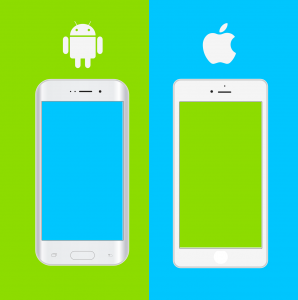
Out of 250 million people in the USA using smartphones, over 113 and 129 million folks use Apple and Android respectively. Apple is the product of Steven Jobs’ brilliant mind, while Android hails from Google’s kitchen. Many investors have bought Apple stock and look forward to their AAPL dividend. It might be a good investment window you have been waiting for.
Besides knowing who owns these two giant operating systems and the number of users using them, what else distinguishes an Apple from an Android phone? Here are five main differences between Apple and Android phones.
1. The language used in the development
Android uses javascript language in the development process. According to many software experts, java is quite intricate to use since it requires one to write many codes. Another alternative for javascript language is Kotlin coding language which operates very well with Android devices. Kotlin was designed as a simpler version of java which is not only easy to write but it is also intuitive. Currently, it is the primary language used in building Android-powered apps.
On the other hand, Apple’s Swift language is like a walk in the park to app developers. Swift is much faster and easy to use compared to java. After its introduction in 2014, many software engineers have continuously praised Swift because its shortcodes consume less time to write.
2. Audience
Statistically, Google Android has command over the numbers of users globally even though it was invented over two decades after Apple stepped on stage. One reason why Android has a large audience is its simplicity. Anybody who can read what is on the screen of an Android-powered smartphone is capable of operating the phone.
On the other side, Apple phones are complex to use. They require users to have a proper understanding of the device’s apps, settings, and displays.
3. The time it takes to develop
There is no question about Android being the slowest to develop due to the length of codes involved. On average, an engineer will spend more time (30% longer) on developing Android apps compared to iOS supported apps. Despite Kotlin being easy to understand and simpler language compared to java, Android apps development processes usually move at snail speed.
4. Hardware and memory
When it comes to hardware, Android phones are more open and compatible with many options compared to Apple products. Android manufacturers offer countless memory expansion options and configurations. Most Android devices have microSD slots you can use as alternative storage space and increase a phone’s carrying capacity. Also, it is easy to share files from Android devices to windows.
On the flip side, iPhones don’t have expandable memory. If you are thinking of buying an iPhone soon, carefully analyze the phone’s internal storage to be on the safer side.
5. Battery life
The life of a battery is an important aspect we are using to compare these two phones. Apple phone’s slim and ultra-light design comes at the expense of the battery. Apple manufacturers make small batteries with limited capacity to ensure their phones are slim, but in the long run, batteries depreciate very fast. Most users report that their phone’s battery requires frequent charging despite Apple incorporating software that enhances battery life in their devices.
In contrast, Android phones have quite a large battery that stores power for many hours. We can’t clearly say that Android devices are thick and heavy to accommodate a larger battery, but to some extent, this is the case. Whether you want a stunning slim phone with poor battery life or leave a nice body behind and go for a powerful battery, you choose between an Android and an Apple phone!
It has been a tough comparison between these two operating systems used to power phones. All in all, Android devices have a complex coding language, longer battery life, and compatible with different hardware. On the other side of the ridge, Apple phones are developed at lightning speed, have fewer users, and shorter battery life.
